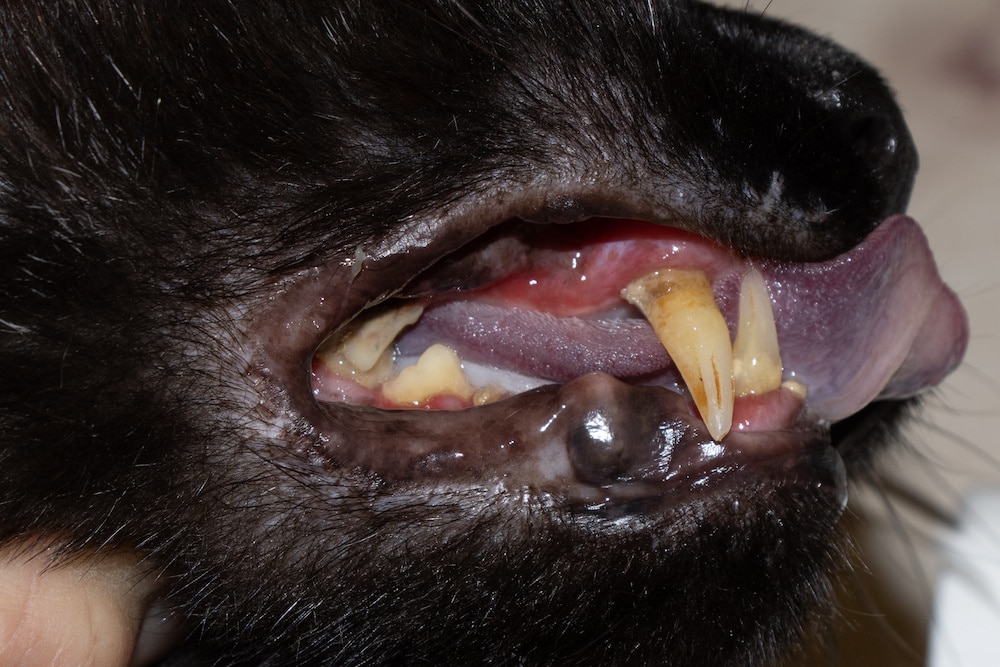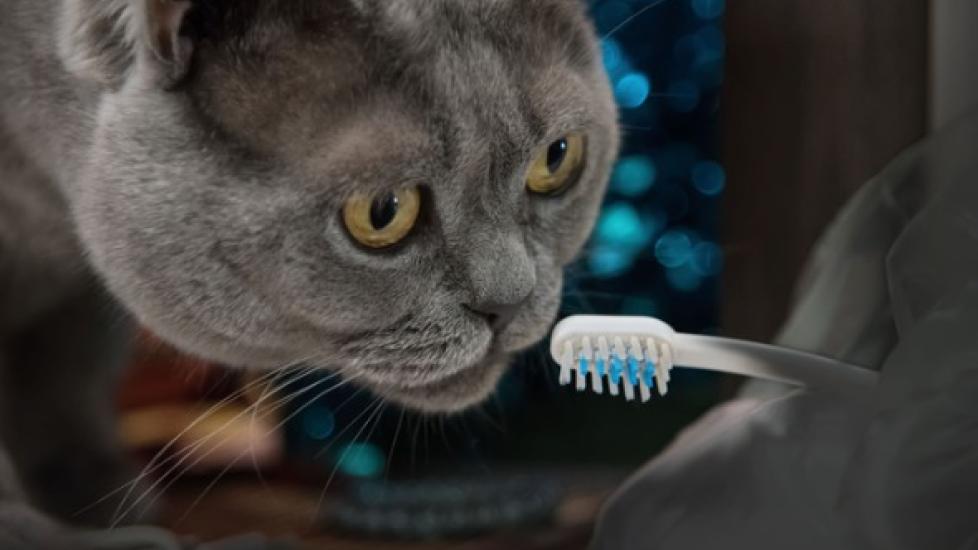Red Gums in Cats
The following content may contain Chewy links. PetMD is operated by Chewy.
Cats are known to hide illnesses, so it can be hard to spot the signs that your cat is sick. One great signal of your cat’s overall health is the color of their gums.
A healthy cat’s gums should be a light shade of pink. If your cat has dark pink or red gums, this could be a sign of an underlying health issue.
It’s also important to note if there are small, pinpoint red bruises or if the redness is only around the base of the teeth or at the gumline. Each of these can mean different things
and can help determine if there is an emerging illness that requires immediate assessment by a veterinarian.
Causes of Red Gums in Cats
Red gums are a symptom of an underlying issue that can range from mild to potentially serious. Some of the reasons your cat’s gums might be red include:
Gingivitis
Gingivitis is a medical condition where the gumline becomes red and swollen. It’s caused by plaque building up along the gumline. Over time, bacteria infiltrate the plaque and trigger an immune reaction. This leads to inflammation, redness, swelling, and pain.
Gingivitis is often caused by poor oral hygiene, tooth crowding, or an underlying illness. It can range from mild to severe and will get worse without appropriate dental therapy from a veterinarian.

Red, inflamed gums on a cat with severe dental disease (Photo credit: Sandra Mitchell, DVM)
Stomatitis
Stomatitis is characterized by severe inflammation that’s spread throughout most or all of the oral cavity, including the gums, tongue, palate, or lips. It often accompanies gingivitis and may be related to an immune response to the bacteria that’s trapped in dental plaque.
It is often very painful and may have symptoms like lethargy, drooling, lack of appetite, and poor grooming practices. If you see these signs at home, bring your feline to a veterinarian for evaluation.
Underlying Illness
Several diseases can cause gingivitis and inflamed gums, including feline immunodeficiency virus (FIV), feline leukemia virus (FeLV), calicivirus, diabetes mellitus, or kidney failure. You might also see severe periodontal disease or ulcerations or the gums and tongue.
Heatstroke
Normal cat body temperatures range from 99 to 102.5°F. Heatstroke in cats can happen when their body temperature reaches 104°F. The most common cause of heatstroke is prolonged exposure to heat without good ventilation.
Cats aren’t great at regulating their body temperatures. They don’t sweat and only rarely pant—two ways of releasing heat from the body. Instead, a cat will typically move to a cooler area to lower their internal temperature. If they can’t get to a cooler spot, their internal temperature can rise to the point where it could cause organ damage or even death.
Obese cats, breeds with flat faces, cats that are ill, kittens, and older cats are more prone to heatstroke. Signs of heatstroke in cats include dark red gums and tongue, rapid heart rate, vomiting, diarrhea, panting or fast respiratory rate, lethargy, disorientation, drooling, or seizures. If you suspect heatstroke, take your cat to a veterinarian immediately, as this can be fatal if left untreated.
Toxins
Cyanide poisoning can cause red gums, dilated pupils, panting, and vomiting in cats. Cyanide poisoning is most commonly caused by eating certain plants, fertilizers, pesticides, or a lot of apple seeds, stems, or leaves. If you’re worried that your cat has ingested cyanide, which can be fatal, take them to a veterinarian immediately.
Rat poison is another common poison that may cause gum discoloration. Some rat poison contains chemicals (anticoagulants) that stop the blood from clotting, which can lead to excess bleeding.
An early sign of rat poisoning is seeing small red dots on the gums, ears, or eyes. This can progress to larger bruises on a cat’s body as well as internal bleeding. This is fatal if left untreated. Take your cat to the veterinarian immediately if you think they were exposed to rat poison or if you see red spots on their gums, ears, or eyes.
Diagnosing the Cause of Red Gums in Cats
The first step to diagnosing the underlying cause of red gums is a thorough history. Your vet will likely ask a lot of questions, including questions about access to toxins in your home or environment, other symptoms, any history of chronic illness, or anything else you might have observed. The vet will also do a physical and oral exam to check your cat’s teeth, gums, palate, lips, and tongue for lesions or changes in color.
Additional tests may include:
-
Viral testing to rule out feline leukemia virus and feline immunodeficiency virus
-
Full blood work and urinalysis to check for disease
-
Clotting times if bruising is noted
-
Dental X-rays to check for periodontal disease
-
Chest X-rays or abdominal imaging with radiographs or ultrasound if the vet is worried about an undiagnosed illness
How Vets Treat Red Gums in Cats
The treatment for red gums in cats depends on the underlying cause:
Gingivitis
Gingivitis is typically treated with appropriate dental care, just like in humans. A yearly dental visit under general anesthesia is typically recommended. During this visit, the vet will remove plaque from your cat’s teeth and gumline.
While your cat is under anesthesia, the vet may also take dental X-rays to look for disease under the gumline. Teeth that are severely affected may be removed. In some cases, you may be referred to a veterinary dentist to perform more in-depth procedures, such as a root canal.
Stomatitis
Stomatitis is not curable, but it may be controlled to reduce the pain. Treatment might include switching to a hypoallergenic diet, steroid therapy to decrease inflammation, and antibiotics to treat underlying bacteria.
In severe cases of stomatitis or if your cat doesn’t respond to the first treatments, full-mouth extractions are often performed to protect your cat’s quality of life. During a full-mouth extraction, the vet will remove all of your cat’s remaining teeth. After this procedure, there is usually a substantial decrease in swelling, redness, and pain.
Underlying Illness
If the redness is caused by an underlying illness—including diabetes, kidney disease, or a feline virus like FIV or FeLV—the vet will focus on treating the condition while relieving any symptoms, including dental symptoms. This might include dental cleanings, antibiotics, steroids, or pulling teeth.
Heatstroke
Treatment for heatstroke usually involves intravenous fluid therapy, appropriate cooling methods, and close monitoring of your cat’s organs.
If you’re attempting to treat your cat at home before you get to the vet, do not submerge them in ice water, as this will drop their temperature too quickly. Instead, place a cool, damp towel under your cat and take them to the veterinarian immediately.
Toxins
Treatment for cyanide poisoning in cats includes hospitalization, intravenous fluid therapy, and treatment with oxygen, methylene blue, and vitamin B12a. Treatment for rodenticide ingestion in cats often involves giving vitamin K1 injections at the veterinary hospital or by mouth at home.
Preventing Red Gums in Cats
The first and best step you can take to protect your cat’s dental health is making sure they have regular dental care, both at home and from a veterinarian. Daily teeth brushing and dental supplements can help keep away tartar and plaque buildup.
Take your cat to the vet for routine dental evaluations and cleanings done under anesthesia. Your vet may also suggest diet modifications, such as offering kibble instead of or alongside canned food, or even switching to a prescription dental diet like Hill’s Prescription Diet Dental Care t/d that has been shown to reduce dental disease in cats.
You can also inspect your cat’s gums periodically. Once or twice a week, gently lift their lips to check the color of their gums and look for any changes in appearance.
To reduce the risk of poisoning or heatstroke, make sure your home and yard are cat-friendly. Remove access to toxins such as rat poisoning. To avoid heatstroke, offer plenty of places for your cat to escape the heat on sweltering days.
Featured image: iStock.com/Marina Troynich
Health Tools
